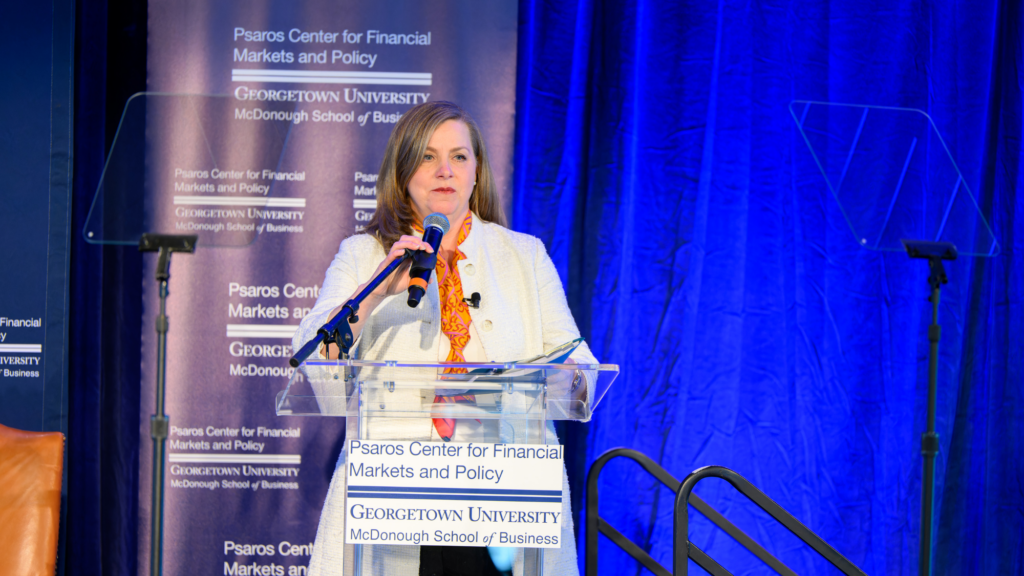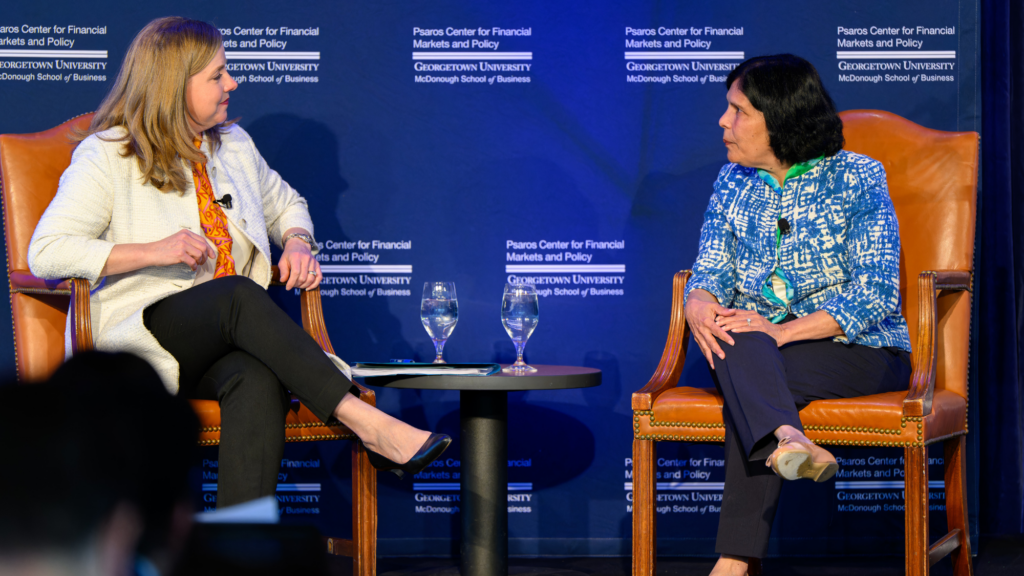Federal Reserve Governor Bowman Discusses Opportunities and Challenges for Creating a U.S. CBDC with the Psaros Center
The Psaros Center for Financial Markets and Policy at Georgetown University’s McDonough School of Business recently hosted The Honorable Michelle Bowman, member of the Board of Governors of Federal Reserve System, for a speech and moderated conversation focused on central bank digital currencies (CBDCs), possibilities for a digital dollar, and the U.S. economy.

Governor Bowman speaking to attendees at the Psaros Center event on April 18
“It is really a pleasure to be here today at Georgetown to discuss the evolving money and payments landscape in the United States which is a topic of primary importance to the Federal Reserve,” Bowman said in her introductory remarks. “Technological innovation has changed the landscape in recent years. As we have seen with the emergence of new financial services, new platforms are designed to increase the speed of payments clearing, settlement, and new forms of digital money.”
During her speech, Bowman explained the developments of CBDCs in international markets and the risks and tradeoffs associated with introducing a retail-focused CBDC in the United States.
“CBDCs are built on a distributed ledger technology that offers a wide range of designs and uses options as well as creating potential risks. This variability complicates any discussion of a CBDC, simply because more likely than not, we are not talking about the same thing,” Bowman said. “Accordingly, several central banks have taken steps to begin exploring the potential uses of CBDCs in their home countries, but only a very small number have adopted a CBDC for their jurisdictions.”
Bowman acknowledged that the Federal Reserve would need to address these risks before moving forward with a potential CBDC.
“While the Federal Reserve plays an important role in these ongoing discussions and the technical research, it is important to understand that the Federal Reserve would not implement a CBDC without the approval of Congress,” Bowman said.
After Bowman’s speech, Reena Aggarwal, Robert E. McDonough Professor of Finance and founding director of the Psaros Center, moderated a discussion with Bowman to address questions about the United States’ role in CBDC conversations and the potential issues that the government will need to address before implementing a digital currency.

Bowman and Agrawal discussed the potential for a U.S. digital dollar during the moderated discussion
Aggarwal asked Bowman where the United States is in terms of planning for a CBDC, in which Bowman acknowledged there is still research to be done in this area.
“We are engaged in technological experimentation and interrogation through partnerships with various universities, and the technical research findings identified several potential capabilities,” Bowman said. “We are continuing to expand technological experiments so when the time is right, we are poised to implement or poised to interact with other countries’ CBDCs if that is an identified opportunity for the United States.”
Aggarwal and Bowman also discussed the concerns surrounding sanctions as a motivation for other countries’ interest in developing CBDCs.
“I think it is important to understand that each country has different motivations for how it is engaging in the thought process of the value of a CBDC, or whether there is not any value for a CBDC exploration for their particular circumstances. This is part of our conversation as we are looking at all aspects of public policy,” Bowman said.
Towards the end of the conversation,Bowman highlighted the Federal Reserve’s commitment to the availability of cash and the safety of the economy.
“Because the Federal Reserve is committed to ensuring the continued safety and availability of cash, a CBDC could be considered as a means to expand safe payments options, not to reduce, or replace them,” Bowman said. “The ongoing exploratory work helps us to think critically about a future shaped by innovators and payment by the broader economy including instant payments and new potential forms of money and payment systems.”
